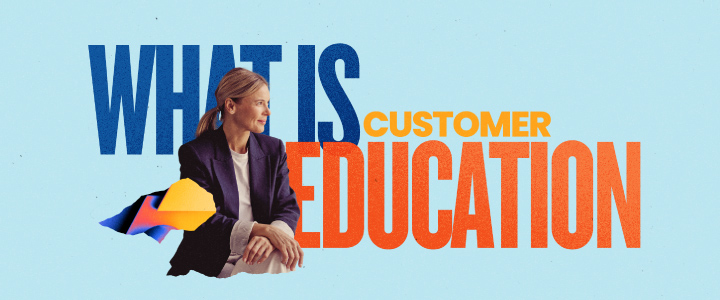
6 min reading time
Best Practices for Customer Education & Training
The Importance of Customer Education
Did you know that only 29% of B2B customers feel fully engaged during onboarding, and that a staggering 85% experience a drop-off in satisfaction in their early experience with a product?
Clearly, customer education is far more than a nice-to-have. It’s an essential part of growing a healthy business, and contributes directly (and significantly!) to higher retention rates and lifetime value, lower support loads, and – ultimately – loyalty and advocacy from your customers.
But what does gold standard customer education look like? How do you make your onboarding and training as effective as possible? This guide will take you through 7 customer education strategies and training best practices for creating a program that engages, empowers, and fosters both success and loyalty in your customers.
Start by Understanding Your Audience
To build a customer education program that truly resonates, begin by getting a clear picture of who your customers are and what common challenges they face with your product. Do they struggle with certain complex features? Are there features they seem to just ignore? Are there recurring questions that pop up in support tickets? How do they prefer to learn? Do they prefer visual guides, video snippets, written articles, or interactive webinars?
Answering these sorts of questions will help you tailor your approach to the specific needs and learning styles of your users, creating a customer education experience that feels personally relevant to them. If you don’t start here, you’ll make assumptions and build something that isn’t as effective as it could be.
Set Clear Goals
Every successful customer education program is built on clear, measurable goals. Usually, these include helping your customers master new features, feel more confident using your product, and reduce their reliance on support. Having these clear objectives in mind will shape how you develop your content and methods, ensuring that each element of your program aligns with what’s most important for your business and your customers.
If it feels too big trying to create something that nails all these goals, just pick the most important one to your business right now. Obsess over it, execute on it, and then bring in the next one.
Regardless of how much you bite off early on, establishing these goals from the start will give you a focused framework for your customer education environment. You’ll get a feel for where you are, and where you want to end up. It’s this clear direction that will help you make consistent, cohesive decisions, and improve user satisfaction and product usability across the board.
Mix Up Learning Methods
When it comes to customer education, one size definitely does not fit all. Different people learn in different ways, and a one-dimensional approach just won’t cut it for everyone. To really engage your customers and help them retain what they learn, it’s essential to offer a variety of learning methods, like:
Interactive Webinars
These are great for learners who benefit from live interaction. Webinars allow customers to ask questions in real-time and get immediate answers, which can make the learning experience feel more personalized and engaging.
Self-paced Modules
For those who prefer to take their time or might need to fit learning into a busy schedule, self-paced modules let them control their learning pace. This method ensures they can fully absorb information without feeling rushed.
Hands-on Workshops
There’s no substitute for practical experience. Workshops that allow hands-on practice can be invaluable for helping learners apply what they’ve learned and truly understand the material.
Animated Explainers and Video Tutorials
Visual learners often benefit from animated explainers and video tutorials that break down complex topics into understandable and engaging content.
Interactive Simulations
Simulations offer an immersive experience that can mimic real-world scenarios, allowing learners to practice skills or use new knowledge in a safe, virtual environment.
Social Learning Platforms
Utilizing forums or social media-style platforms encourages peer-to-peer interaction and learning, which can be especially effective for those who learn best through discussion and collaboration.
Mixing up your training formats allows your customers to choose what best suits their learning style.
Make Content Relevant and Engaging
To create engaging customer education content, you need to tailor it specifically to the real challenges and tasks your customers encounter daily. By weaving in real-world scenarios, your lessons become immediately usable.
Share stories of customers who’ve overcome challenges or achieved great things with your product. Stories like these don’t just highlight the benefits of your product—they make the learning experience more engaging and emotionally impactful.
Keep your content fresh. Regular updates that reflect the latest product changes and market trends keep learners coming back for more. Actively seeking and using feedback from your users also helps you fine-tune the content to better meet their specific needs.
By blending these personalized touches with the varied learning methods we’ve discussed, your education program becomes dynamic, adaptive, continuous, and effective.
Leverage The Best Technology
As your business grows, so should the technology that supports your customer education. That’s why it’s crucial to invest in a first-rate Learning Management System (LMS). These platforms aren’t just about organizing and delivering your education program; they do advanced things like using AI and machine learning to customize the learning experience, making it more engaging and effective for everyone.
The best LMS for you will also mesh well with the tools you already use, ensuring everything works smoothly together. Plus, the deep insights you get from LMS analytics will help you tweak your training in real-time, based on what’s working for your users.
Embracing top-notch tech means your educational efforts can scale and adapt as your company does, supporting your current needs while preparing you for future growth.
Prevent Common Training Challenges
Even the best-designed training programs face hurdles. Here are some of the more common issues, with strategies to help you combat them:
Limited Engagement
Increase interaction by integrating diverse interactive and multimedia elements like quizzes, simulations, and feedback mechanisms to keep learners actively involved.
Outdated Content
Regularly review and update training materials to reflect the latest industry standards and technological advancements, and – if you need to – involve subject matter experts for accuracy.
Scalability Issues
Choose a scalable learning management system and design courses in modular formats so you can easily manage growing user numbers without compromising quality.
Technical Difficulties
Implement robust technical support and provide clear troubleshooting guides to help learners navigate any issues that arise during the training process.
Accessibility Barriers
Ensure all training materials are accessible to everyone by following best practices for accessibility, such as including captions for videos, using screen reader-friendly designs, and offering materials in multiple formats.
Language and Cultural Differences
Offer training content in multiple languages and consider cultural nuances to make the training relevant for a global audience.
Lack of Practical Application
Include case studies, real-world applications, and hands-on projects that allow learners to apply what they’ve learned in realistic scenarios.
Insufficient Feedback Mechanisms
Develop a proper feedback loop that allows for continuous input from learners about their experiences and the effectiveness of their training. This is key to ongoing improvement.
Be sure to proactively address these areas before they become issues.
Measure Success and Embrace Continuous Improvement
To understand how well your customer education program is working, it’s essential to measure your customer education effectiveness. Start by setting clear, specific metrics: track things like course completion rates, how often customers use your product after training, depth of engagement with new features, and overall satisfaction levels.
But measuring success is just the beginning. Continuously gathering feedback allows you to fine-tune and improve your training continuously. This feedback is crucial for adapting your program to better meet your customers’ needs.
Staying updated with the latest in learning technologies and methods is also key. Regularly refreshing your program with new tools and approaches ensures it remains relevant and effective, keeping your training fresh and engaging for customers. This ongoing commitment to improvement will help maintain the high impact of your educational efforts over time.
Now Take Your Customer Education and Training Further
Customer education is more than a series of training sessions or resources; it’s an ongoing journey that nurtures continuous growth and improvement in your customer base, benefiting both them and your business. By embracing the best practices we’ve just gone through, you’ll create a learning environment that engages and inspires your customers, enhances their experience with your product, and deepens their connection to your brand.
Want some help assessing the impact of your current program and pinpointing clear areas for improvement? Take a look at our free Training Evaluation Form Template. It’s an excellent resource that will help you clearly evaluate where you’re currently at and what you could be doing better.




